Attracting Butterflies to our Garden
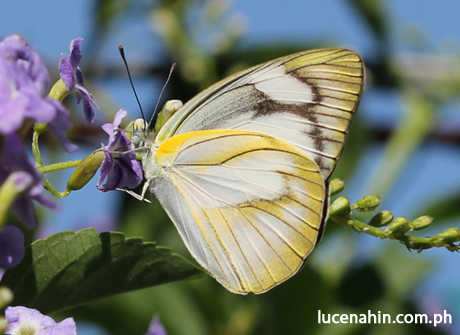 We have more than 900 different species of butterflies here in the Philippines. Pictured on the right is a female Striped Albatross (Appias olfern), a regular visitor in our garden at this time. Aside from their beauty, butterflies also serve as pollinators for plants and food source for other animals like birds and spiders. Butterflies are also considered as indicator species. Because butterflies are sensitive to the changes in their surroundings among other things, scientists use them to help determine the current health of the environment.
We have more than 900 different species of butterflies here in the Philippines. Pictured on the right is a female Striped Albatross (Appias olfern), a regular visitor in our garden at this time. Aside from their beauty, butterflies also serve as pollinators for plants and food source for other animals like birds and spiders. Butterflies are also considered as indicator species. Because butterflies are sensitive to the changes in their surroundings among other things, scientists use them to help determine the current health of the environment.
If you want to attract butterflies to your garden, here are some things that you can do to get started:
Provide food and water
Butterflies will easily recognize food in your garden when you plant native flowering plants. Most butterflies prefer yellow, red and blue flowers and your garden should have enough diversity that flowers are available whole year round. Group the same plants together so the butterflies can spot them easily from afar. This is the complete opposite of what we do with most of our vegetables, where we plant them separately so pests will have a harder time to find them.
Some butterfly species also feed on weeds like Uray, Tawa-Tawa and Agas-Moro. Ripe and rotting sliced fruits can be served in a tray. And you can also create a butterfly bath filled with moist sand for puddling. We only have bird baths with landing stones in our garden though, and we occasionally leave overripe fruits on top of our mulch.
In addition to providing food for the butterflies, you will also need to provide host plants for the caterpillars. Different caterpillars usually have different and very specific preferences – and yes they will feed on the leaves of your plants. Common host plants include Calamansi (or other Citrus trees), Guyabano, Atis and common weeds like Cleome Rutidosperma.
Avoid Chemical Fertilizers and Pesticides
Butterflies and caterpillars are killed easily by pesticides and many chemicals. What I like most about a permaculture garden is the idea that nature will take care of itself if we let her. In a healthy ecosystem, there’s a balance between preys and predators – pests and beneficial insects, so we avoid using any pesticides and chemical fertilizers in our garden. And in doing so, have helped attract more butterflies to the garden.
The Butterflies that visit our Garden
We are now noticing lots of butterflies daily, along with bees, which wasn’t how things used to be especially when we were just getting started. I usually find more butterflies in the morning when the sun is up than in the afternoon, but maybe that is something seasonal.
The butterfly photos in this post were taken during the sunny days of the last 2 weeks of August 2015 from around 7:30 to 9:00 AM using Canon 60D and a 100mm Macro Lens. It may seem that they prefer the same flowers but not necessarily. It was just easier for me to photograph them from the same spot. There were also other butterfly species that came but didn’t stay still long enough for me to capture on camera.
Brown Soldier (Junonia hedonia)
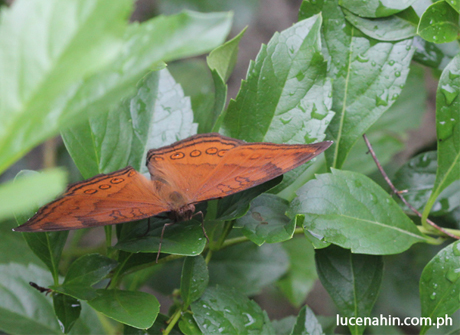
Common Five Ring (Ypthima stellera)
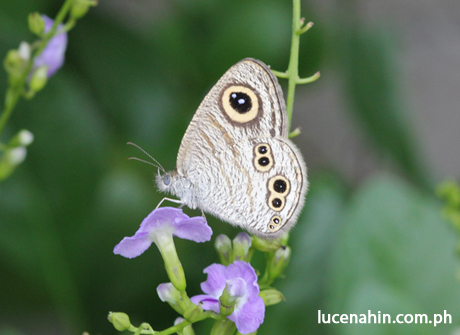
Common Leopard (Phalanta phalantha)
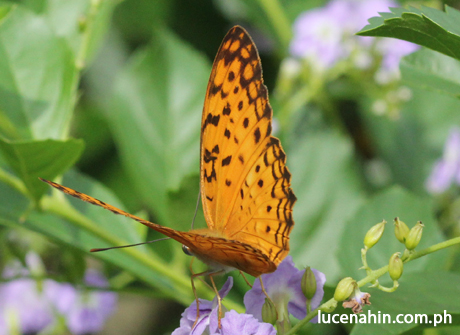
Common Lime Swallowtail (Papilio demoleus)
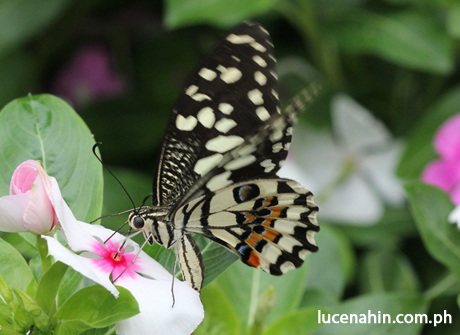
Common Snowflat (Tagiades japetus)
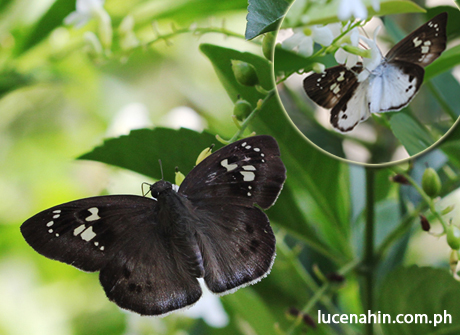
Common Wanderer (Pareronia valeria)
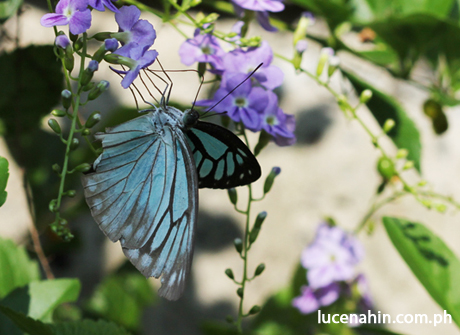
Large Grass Yellow (Eurema hecabe)
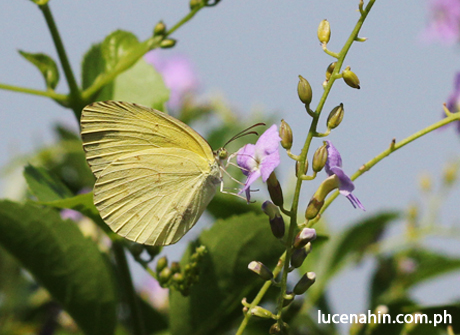
Luzon Grass Dart (Taractrocera luzonensis)
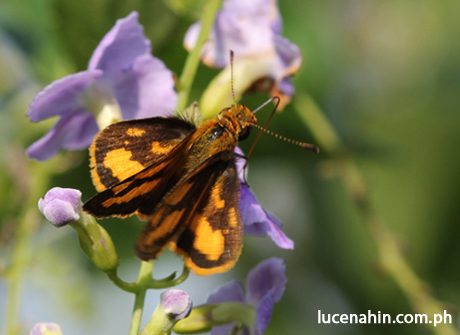
Malayan Eggfly (Hypolimnas anomala)
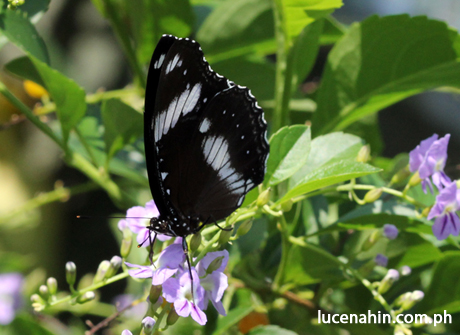
Psyche (Leptosia nina malayana)
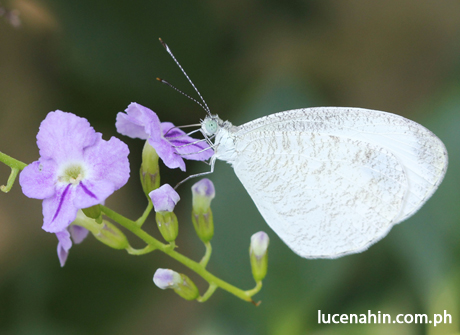
Aside from the butterflies above, I’ve also seen a Peacock Pansy, a Common Bluebottle, a Common Mormon and a Tailed Jay on other days, which would have been an added joy to shoot if I had my camera with me. Can you imagine other kinds of butterflies that visit the garden while we’re not there? 🙂
Attracting butterflies is as easy as providing food, water and avoiding chemicals. When you make your garden attractive to butterflies, you’ll also find more bees, insects, and other animals, all working together to make your garden productive and abundant.
References:
Butterflies of Singapore http://butterflycircle.blogspot.sg/
Butterflies in the Philippines https://www.projectnoah.org/missions/15553007
http://pbh-butterflies.yolasite.com/philippine-butterflies.php
http://butterflycircle.blogspot.com/2010/06/life-history-of-striped-albatross.html
http://www.onegreenplanet.org/environment/how-the-butterfly-can-shape-an-ecosystem-and-why-we-need-to-protect-them/
http://www.natureconservancy.ca/en/what-you-can-do/conservation-volunteers/see-us-in-action/for-the-love-of-birds-and.html
http://butterfly-conservation.org/45/why-butterflies-matter.html
https://en.wikipedia.org/wiki/List_of_butterflies_of_the_Philippines

 Philippine Peso
Philippine Peso